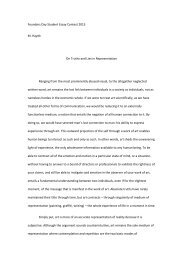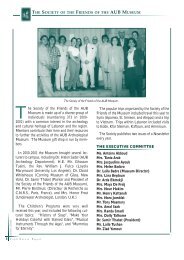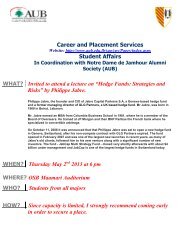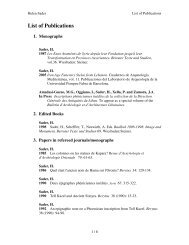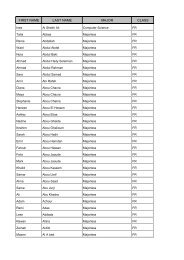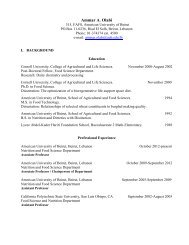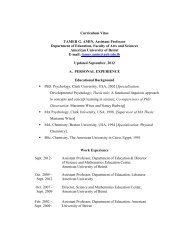T h e I X t h M a k a s e d M e d i c a l C o n g r e s s 6. Horstkotte D, Loogen F: <strong>The</strong> natural history <strong>of</strong> aortic valve stenosis. Eur Heart J 1988, 9(Suppl E):57–64. 7. Iivanainen AM, Lindroos M, Tilvis R, et al.: Natural history <strong>of</strong> aortic valve stenosis <strong>of</strong> varying severity in the elderly. Am J Cardiol 1996, 78:97–101. 8. Chizner MA, Pearle DL, deLeon AC Jr: <strong>The</strong> natural history <strong>of</strong> aortic stenosis in adults. Am Heart J 1980, 99:419–424. 9. Varadarajan P, Kapoor N, Bansal RC, Pai RG: Clinical pr<strong>of</strong>i le and natural history <strong>of</strong> 453 nonsurgically managed patients with severe aortic stenosis. Ann Thorac Surg 2006, 82:2111–2115. 10. Iung B, Cachier A, Baron G, et al.: Decision-making in elderly patients with severe aortic stenosis: why are so many denied surgery? Eur Heart J 2005, 26:2714–2720. 11. Bouma BJ, van Den Brink RB, van Der Meulen JH, et al.: To operate or not on elderly patients with aortic stenosis: the decision and its consequences. Heart 1999, 82:143–148. 12. Pai RG, Kapoor N, Bansal RC, Varadarajan P: Malignant natural history <strong>of</strong> asymptomatic severe aortic stenosis: benefi t <strong>of</strong> aortic valve replacement. Ann Thorac Surg 2006, 82:2116–2122. 13. Bach DS, Cimino N, Deeb GM: Unoperated patients with severe aortic stenosis. J Am Coll Cardiol 2007, 50:2018–2019. 14. Cribier A, Eltchanin<strong>of</strong>f H, Tron C, et al.: Treatment <strong>of</strong> calcifi c aortic stenosis with the percutaneous heart valve: mid-term follow-up from the initial feasibility studies: the French experience. J Am Coll Cardiol 2006, 47:1214–1223. 15. Grube E, Laborde JC, Gerckens U, et al.: Percutaneous implantation <strong>of</strong> the CoreValve self-expanding valve prosthesis in high-risk patients with aortic valve disease: the Siegburg fi rst-in-man study. Circulation 2006, 114:1616–1624. 16. Webb JG, Chandavimol M, Thompson CR, et al.: Percutaneous aortic valve implantation retrograde from the femoral artery. Circulation 2006, 113:842–850. 17. Vassiliades TA Jr, Block PC, Cohn LH, et al.: <strong>The</strong> clinical development <strong>of</strong> percutaneous heart valve technology. J Thorac Cardiovasc Surg 2005, 129:970–976. 18. Walther T, Simon P, Dewey T, et al.: Transapical minimally invasive aortic valve implantation: multicenter experience. Circulation 2007, 116(11 Suppl):I240–I245. 19. Block PC, Bonhoeffer P: Percutaneous approaches to valvular heart disease. Curr Cardiol Rep 2005, 7:108–113. 20.• Zajarias A, Cribier AG: Outcomes and safety <strong>of</strong> percutaneous aortic valve replacement. J Am Coll Cardiol 2009, 53:1829–1836. This is a concise review <strong>of</strong> the current status <strong>of</strong> TAVI. 21. Webb JG, Altwegg L, Boone RH, et al.: Transcatheter aortic valve implantation: impact on clinical and valve-related outcomes. Circulation 2009, 119:3009–3016. 22. Andersen HR, Knudsen LL, Hasenkam JM: Transluminal implantation <strong>of</strong> artifi cial heart valves. Description <strong>of</strong> a new expandable aortic valve and initial results with implantation by catheter technique in closed chest pigs. Eur Heart J 1992, 13:704–708. 23. Webb JG, Altwegg L, Masson JB, et al.: A new transcatheter aortic valve and percutaneous valve delivery system. J Am Coll Cardiol 2009, 53:1855–1858. 24.•• Webb JG, Pasupati S, Humphries K, et al.: Percutaneous transarterial aortic valve replacement in selected high-risk patients with aortic stenosis. Circulation 2007, 116:755–763. This landmark article describes the balloon-expandable valve. Transcatheter Aortic Valve Implantation Kapadia and Tuzcu 475 90 25. Lichtenstein SV, Cheung A, Ye J, et al.: Transapical transcatheter aortic valve implantation in humans: initial clinical experience. Circulation 2006, 114:591–596. 26. Ye J, Cheung A, Lichtenstein SV, et al.: Six-month outcome <strong>of</strong> transapical transcatheter aortic valve implantation in the initial seven patients. Eur J Cardiothorac Surg 2007, 31:16–21. 27. Walther T, Falk V, Borger MA, et al.: Minimally invasive transapical beating heart aortic valve implantation—pro<strong>of</strong> <strong>of</strong> concept. Eur J Cardiothorac Surg 2007, 31:9–15. 28. Svensson LG, Dewey T, Kapadia S, et al.: United States feasibility study <strong>of</strong> transcatheter insertion <strong>of</strong> a stented aortic valve by the left ventricular apex. Ann Thorac Surg 2008, 86:46–54; discussion 55. 29. Grube E, Laborde JC, Zickmann B, et al.: First report on a human percutaneous transluminal implantation <strong>of</strong> a self-expanding valve prosthesis for interventional treatment <strong>of</strong> aortic valve stenosis. Catheter Cardiovasc Interv 2005, 66:465–469. 30. Grube E, Schuler G, Buellesfeld L, et al.: Percutaneous aortic valve replacement for severe aortic stenosis in high-risk patients using the second- and current thirdgeneration self-expanding CoreValve prosthesis: device success and 30-day clinical outcome. J Am Coll Cardiol 2007, 50:69–76. 31.• Kapadia SR, Svensson L, Tuzcu EM: Successful percutaneous management <strong>of</strong> left main trunk occlusion during percutaneous aortic valve replacement. Catheter Cardiovasc Interv 2009, 73:966–972. This interesting case report sheds light on coronary ostial compromise after percutaneous AVR. 32. Kodali S: Edward’s valve experience. Presented at the 20th Annual Transcatheter Cardiovascular <strong>The</strong>rapeutics Meeting. Washington, DC; October 12–17, 2008. 33. Webb JG: Vancouver experience. Presented at the 20th Annual Transcatheter Cardiovascular <strong>The</strong>rapeutics Meeting. Washington, DC; October 12–17, 2008. 34. Lefevre T: European experience with balloon expandable valve. Presented at the 20th Annual Transcatheter Cardiovascular <strong>The</strong>rapeutics Meeting. Washington, DC; October 12–17, 2008. 35.• Grube E, Buellesfeld L, Mueller R, et al.: Progress and current status <strong>of</strong> percutaneous aortic valve replacement: results <strong>of</strong> three device generations <strong>of</strong> the CoreValve revalving system. Circ Cardiovasc Interv 2008, 1:167–175. <strong>The</strong> authors report on the safety and effi cacy <strong>of</strong> the self-expanding CoreValve system. 36. Bleiziffer S, Ruge H, Mazzitelli D, et al.: Results <strong>of</strong> percutaneous and transapical transcatheter aortic valve implantation performed by a surgical team. Eur J Cardiothorac Surg 2009, 35:615–620; discussion 620–621. 37. Tamburino C, Capodanno D, Mul EM, et al.: Procedural success and 30-day clinical outcomes after percutaneous aortic valve replacement using current third-generation self-expanding CoreValve prosthesis. J Invasive Cardiol 2009, 21:93–98. 38. Laborde JC: CoreValve experience. Presented at the 58th Annual Meeting <strong>of</strong> the <strong>American</strong> College <strong>of</strong> Cardiology. Orlando, FL; March 29–31, 2009.
EMERGENT CORONARY ANGIOGRAM FOR GRAFT FAILURE SUSPICION AFTER CORONARY ARTERY BYPASS GRAFTING: THE MONTREAL HEART INSTITUTE EXPERIENCE Gilbert Gosselin, MD Between September 2000 and August 2008, we identified 58 consecutive patients who underwent a coronary angiogram following CABG during the same hospital admission for suspected myocardial ischemia. Patients were divided in 2 groups: conservative treatment (group 1) and revascularization (group 2). We reviewed the medical records <strong>of</strong> all 58 patients as well as the pre-operative and post-CABG angiographies. Results Among a total <strong>of</strong> 158 inserted grafts, 50 (32%) were identified as failing ones. <strong>The</strong> most common cause <strong>of</strong> graft failure was graft occlusion or subtotal (> 70%) anastomotic stenosis (n=35), followed by graft kinking (n=11). Diffuse post-operative graft vasospasm was found in 4 patients. Conservative treatment was decided for 23 patients (39.7%) and percutaneous revascularization was the treatment in 35 patients (60.3%) . When conservative treatment was decided, the left internal mammary artery (LIMA) graft was functional in all cases. Revascularizations were performed on the native coronary arteries in 26 cases (74.3%). In 31.4% (31 pts), the revascularization was realized in or through the graft. One intervention was complicated by anastomosis rupture during stent implantation. <strong>The</strong> 30-day mortality was 19% (11 pts) in the whole cohort and reached 29% in the revascularization group (10 pts). Conclusions Overtime rescue PCI following failed CABG was increasingly used in our institution. Anastomotic lesions should be considered with caution considering the risk <strong>of</strong> rupture. OPTIMAL ANTIPLATELETS THERAPY IN ACUTE CORONARY SYNDROME BEFORE INTERVENTION Gilbert Gosselin, MD ASA has been used as a standard therapy for ACS along with heparin following the paper <strong>of</strong> Dr Théroux in the New England Journal <strong>of</strong> Medicine in 1992. With the use <strong>of</strong> PCI and stents in ACS patients, the use <strong>of</strong> thiopyridines was established, first with ticlopidine and more recently with clopidogrel. In spite <strong>of</strong> many in vitro trials, the optimal dose <strong>of</strong> clopidogrel as well as ASA is not established in ACS patients undergoing intervention. <strong>The</strong> results <strong>of</strong> the CURRENT trial will give us an answer to these questions. More recent drugs (prazugrel…) will soon be widely available and be part <strong>of</strong> our optimal medical treatment. 91






